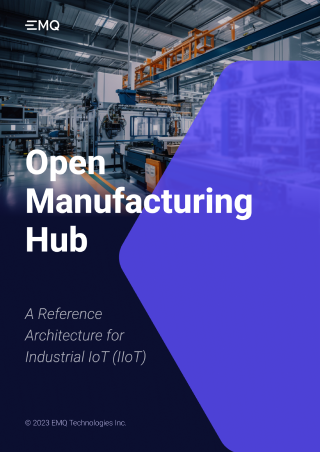Implementing Unified Namespace Using EMQX and NeuronEX

Table of Contents
In our previous blogs, we discussed the concepts of ISA95 and unified namespaces. In this blog, we will explore the intricacies of implementing a unified namespace with EMQX and NeuronEX, highlighting the synergy between these platforms and the myriad benefits they bring. From data integration and transformation to multi-site data replication, we will show how this integration best addresses the challenges of data organization, scalability and collaboration in an industrial context. By converging EMQX's MQTT capabilities with NeuronEX's data transformation capabilities, organizations can realize in a new era of unified data access, streamlined processes, and data-driven decision making.
Unified Namespace Solution with EMQX and NeuronEX
The Unified Namespace (UNS) concept redefines data access, allowing all network participants to interact with information, irrespective of its physical location. EMQX broker and NeuronEX is a popular choice for implementing UNS due to its efficiency and scalability.
EMQX plays a pivotal role as the central messaging broker, strategically positioned at its core. NeuronEX supports the EMQX to access OT sensors and devices with various industrial protocols. As the key components for data communication and message routing, EMQX and NeuronEX together act as the primary conduit connecting data sources, such as devices, sensors, and machines to data consumers, which includes ERP and MES applications, databases, and analytics platforms. This intermediary role enables seamless data exchange within the manufacturing ecosystem, facilitating the flow of information critical to real-time monitoring, control, and analysis.

Design of the Common Naming Convention
Unified Namespace, however, is not solely about technology. It's a strategic design approach that organizes data into a coherent structure, fostering contextual understanding. This design creates common naming conventions for participants to access data, enabling collaboration and efficient decision-making across the network. Common naming conventions refer to the set of rules, guidelines, and patterns that dictate how names should be created and used for various entities, objects, variables, files, or other elements within a system, organization, or domain.
In EMQX broker, every connected device and application adheres to this standardized MQTT topic hierarchy, rooted in a consistent set of naming conventions and data models. This convention ensures that all devices and applications use a standardized framework for addressing and interacting with each other. By adopting the same MQTT topic hierarchy and data models, devices and applications can effortlessly communicate, regardless of their disparate origins or protocols. This eradicates the barriers that might hinder data exchange in heterogeneous environments.
Naming conventions are particularly important in programming, software development, data management, and various other fields to ensure consistency, clarity, and ease of understanding when referring to different MQTT topic names. Moreover, Incorporating the naming conventions into asset management processes can significantly streamline operations, enhance data-driven decision-making, and contribute to overall business success by maximizing the value and efficiency of assets across their lifecycle.
Architecture for Implementing Unified Namespace
The Unified Namespace solution emerges as a powerful mechanism to seamlessly integrate devices, applications, and data streams. By using EMQX and NeuronEX, this solution can be architected into a three-tier structure, ensuring efficient data exchange, organization, and consumption. In the diagram shown, all connected devices and applications are separated into two primary layers. The bottom is the automation layer, while the top is the application layer. The middle layer serves as a conduit through which EMQX and NeuronEX enable seamless data exchange between automation and application layers.

Empowering Analytics and Decision-Making
The Application Layer is where the true value of unified data comes to life. Applications residing within this layer possess the capability to dive into the wealth of contextualized data and perform sophisticated analytics. Utilizing this data, applications can uncover patterns, trends, and anomalies that might go unnoticed with raw data. Predictive maintenance, a prime example, enables the proactive identification of potential equipment failures, preventing costly downtime and production interruptions.
Real-Time Updates for Swift Responses
The architecture's beauty lies in its real-time responsiveness. Applications in the Application Layer can subscribe to specific data points or device nodes, allowing them to receive instant updates. This feature empowers factories to swiftly respond to changes in the production process, maintaining operational agility and adaptability.
Elevating AI/ML Capabilities
One of the most remarkable advantages of contextualized data is its impact on AI/ML models. By supplementing raw data with additional context and metadata, AI/ML models can better comprehend and interpret the data they receive. This reduction in interpretation errors leads to enhanced accuracy and more reliable insights.
Enhanced Predictive Capabilities
Contextualized data significantly amplifies the predictive prowess of AI/ML models. The provision of additional context empowers models to make precise predictions about forthcoming events or outcomes. As a result, factories can foresee potential challenges, optimize processes, and make proactive decisions that drive efficiency and productivity.
Revolutionizing Data Quality and Interpretation
The Application Layer's access to contextualized data serves as a cornerstone in improving data quality. Through the inclusion of metadata and context, data fed into AI/ML models becomes more reliable, leading to higher-quality predictions and outcomes.
EMQX Clustering for Multisites Data Replication
The need for efficient data integration and consistent access across disparate industrial systems has given rise to the Unified Namespace Architecture. This transformative approach overcomes data isolation, promotes collaborative synergy, and optimizes data-driven analytics by creating a harmonized environment for data aggregation. There are two types of deployments of the Unified Namespace Architecture as below.
Single-Sites Deployment
Within a single-site deployment, the architecture revolves around the careful orchestration of various components to create a unified namespace. On the left side of the diagram are the data sources from the production floor, which is the automation layer of the 3-tier architecture above. The right side is the central control room where all data analysis and storage takes place. In the middle is a unified namespace enabled by EMQX and NeuronEX.

- EMQX Cluster Management: The foundation is laid by deploying an EMQX broker cluster under the supervision of the EMQX Edge Cloud Platform (ECP). The inherent scalability of the EMQX ECP allows seamless scaling of EMQX instances to address escalating data demands.
- NeuronEX Gateway Integration: NeuronEX gateways, also governed by EMQX ECP, play a key role in bridging the gap between on-premises Operational Technology (OT) devices (e.g., PLCs, CNC machines) and Information Technology (IT) systems. NeuronEX's data format conversion and intercommunication capabilities are used to ensure seamless data flow.
- Enabling eKuiper Rule Engine: The deployment of eKuiper streaming engines, managed by EMQX ECP, is essential for processing streaming messages emanating from IT systems and NeuronEX gateways. Configuring eKuiper's data storage or command transmission capabilities enriches the processing cycle.
- NanoMQ Facilitation: NanoMQ is strategically deployed as an agile bridge tailored for edge scenarios housing multiple applications. Its lightweight composition ensures optimal data exchange efficiency, particularly for hardware with constrained resources.
- Unified Namespace Enrichment: The synergy achieved through the collaboration of EMQX cluster, EMQX ECP, NeuronEX, eKuiper, and NanoMQ culminates in the establishment of a Unified Namespace. This expansive realm embraces data from diverse OT devices, IT systems, application platforms (e.g., Kafka, Redis, PostgreSQL), and cloud analytics systems (e.g., AI/ML).
Multi-Sites Deployment
In a multi-site deployment, the architecture's scope broadens to encompass diverse production sites. The Unified Namespace spans the entire production process, whether vertical or horizontal, across multiple geographic locations. This includes the central control room where all production information, even down to the sensors, is processed by various applications and AI/ML for better decisions.

- Inter-Site Data Replication: EMQX clusters, meticulously distributed across multiple production sites, enable the seamless replication of data messages. This empowers the realization of cross-site data sharing, fostering a unified data ecosystem.
- Contextualized Data Organization: The essence of the Unified Namespace emerges as all data messages find their place within a contextualized structure. The tenets of ISA-95 guide the structuring, capturing assets, processes, and the intricate tapestry of data relationships.
- Holistic Multi-Site Advantages: This architectural extension enables real-time data sharing and harmonized collaboration across disparate manufacturing sites. Decision-makers gain access to synchronized, up-to-date data, fostering informed decisions across the enterprise.
Conclusion
The deployment of a Unified Namespace architecture, whether in a single-site or multi-site scenario, signifies a revolutionary step toward optimized industrial data integration. By leveraging the collaborative capabilities of EMQX and NeuronEX, organizations can break down data barriers, foster collaboration, and make data-driven decisions. This unified approach not only enhances operational efficiency but also propels industries toward a more connected and intelligent future, where data flows seamlessly to enable innovation and excellence.
